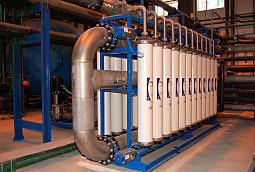
Ultrafiltration"HydroTech Engineering" Co Ltd applies the ultrafiltration systems for clarification and purification of many available water resources, such as drilled-wells, surface water, waste waters and systems for posttreatment of municipal water. Ultrafiltration is the most effective technological process available for water clarification or feed water treatment for nanofiltration, reverse osmosis and ion-exchange. This technology provides a barrier against microorganisms and particles. Ultrafiltration is used for the removal of suspended solids, decreasing the turbidity and the content of any organic substances (reduction of Chemical Oxygen Demand and Biological Oxygen Demand). During this process you can obtain such water characteristics, as:
Ultrafiltration membranes are modules containing thousands of capillaries with an internal diameter of 0.7-1.0 mm. These modules consist of a polyethersulphone (PES) material with special added components. This is a hydrophilic material resistant to organic fouling. The filtration area of one module is from 30 to 70 m2. The water flow moves from the inside out, i.e. the flow enters the capillaries and the resulting filtrate exits via their walls. It is possible to obtain reversal of filtration direction. Ultrafiltration membranes are designed for removal of suspended solids. Pressurized water flows through the membrane, but particles remain trapped on the membrane surface. Due to the small pore size of membranes, all suspended solid particles and microorganisms are effectively removed from the water. As these particles form a sedimentary layer on the membrane surface, reversing the flow will remove that layer (backwashing). Ultrafiltration is one of the best technologies used to filter drinking water. This can be observed from the year-on-year output volume increase of 25%.
We can conclude that membrane application is consistently and rapidly growing. Membrane installations recover clean water from any water flow. Since 1995, the market of membrane clarification is developing very quickly. The effectiveness of membranes is increasing and their cost is decreasing. Thus, such problems as energy consumption, clogging risks and membrane cost are now insignificant. Ultrafiltration replaces conventional clarification systems for the production of drinking or technical water; it provides water treatment required for the use of RO systems. Application Drinking Water Production. Ultrafiltration may be used for one-stage water treatment, as well as in combination with coagulation, sludging, clarification or flotation. Desalination and water reusability. Ultrafiltration is used for the removal of clogging particles of the membrane before feeding into the reverse osmosis system. Primarily, the Ultrafiltration membrane applications are effective for municipal waste water reuse, irrigation systems and other water resources. Waste water treatment by the membrane bioreactor. Bioreactors use submerged membranes with an internal filtration surface. The membrane bioreactor is an effective method for municipal waste water treatment and industrial waste water treatment of the food and pulp-paper industries. Advantages In comparison with conventional filtering methods, ultrafiltration has a lot of advantages:
|




